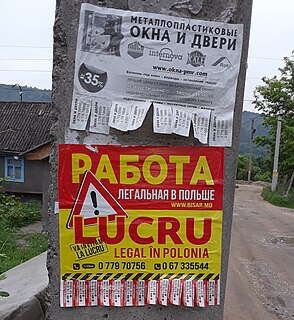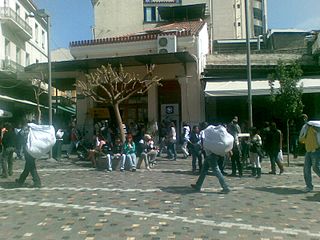Related Research Articles

Human migration is the movement of people from one place to another with intentions of settling, permanently or temporarily, at a new location. The movement often occurs over long distances and from one country to another, but internal migration is also possible; indeed, this is the dominant form of human migration globally. Migration is often associated with better human capital at both individual and household level, and with better access to migration networks, facilitating a possible second move. Age is also important for both work and non-work migration. People may migrate as individuals, in family units or in large groups. There are four major forms of migration: invasion, conquest, colonization and emigration/immigration.

Foreign workers or guest workers are people who work in a country other than one of which they are a citizen. Some foreign workers use a guest worker program in a country with more preferred job prospects than in their home country. Guest workers are often either sent or invited to work outside their home country or have acquired a job before leaving their home country, whereas migrant workers often leave their home country without a specific job in prospect.

A migrant worker is a person who migrates within a home country or outside it to pursue work. Migrant workers usually do not have the intention to stay permanently in the country or region in which they work.
Transnationalism is a research field and social phenomenon grown out of the heightened interconnectivity between people and the receding economic and social significance of boundaries among nation states.

The International Convention on the Protection of the Rights of All Migrant Workers and Members of Their Families is a United Nations multilateral treaty governing the protection of migrant workers and families. Signed on 18 December 1990, it entered into force on 1 July 2003 after the threshold of 20 ratifying States was reached in March 2003. The Committee on Migrant Workers (CMW) monitors implementation of the convention, and is one of the seven UN-linked human rights treaty bodies. The convention applies as of August 2021 in 56 countries.

A remittance is a non-commercial transfer of money by a foreign worker, a member of a diaspora community, or a citizen with familial ties abroad, for household income in their home country or homeland. Money sent home by migrants competes with international aid as one of the largest financial inflows to developing countries. Workers' remittances are a significant part of international capital flows, especially with regard to labor-exporting countries.
Chain migration is the social process by which immigrants from a particular area follow others from that area to a particular destination. The destination may be in another country or in a new location within the same country.
Mixtec transnational migration is the phenomenon whereby Mixtec people have migrated between Mexico and the United States, for over three generations.

Immigration is the international movement of people to a destination country of which they are not natives or where they do not possess citizenship in order to settle as permanent residents or naturalized citizens. Commuters, tourists, and other short-term stays in a destination country do not fall under the definition of immigration or migration; seasonal labour immigration is sometimes included, however.
African immigrants in Europe are individuals residing in Europe who were born in Africa, this includes both individuals born in North Africa and Sub-Saharan Africa.

Immigration to Greece percentage of foreign populations in Greece is 7.1% in proportion to the total population of the country. Moreover, between 9 and 11% of the registered Greek labor force of 4.4 million are foreigners. Migrants additionally make up 25% of wage and salary earners.

Circular migration or repeat migration is the temporary and usually repetitive movement of a migrant worker between home and host areas, typically for the purpose of employment. It represents an established pattern of population mobility, whether cross-country or rural-urban. There are several benefits associated with this migration pattern, including gains in financial capital, human capital, and social capital. There also costs associated with circular migration, such as brain drain, poor working conditions, forced labor, and the inability to transfer acquired skills to home economies. Socially, there are strong connections to gender, health outcomes, development, poverty, and global immigration policy.
International migration occurs when people cross state boundaries and stay in the host state for some minimum length of the time. Migration occurs for many reasons. Many people leave their home countries in order to look for economic opportunities in another country. Others migrate to be with family members who have migrated or because of political conditions in their countries. Education is another reason for international migration, as students pursue their studies abroad, although this migration is often temporary, with a return to the home country after the studies are completed.

During the period of 1965 - 2021, an estimated 440,000 people per year emigrated from Africa; a total number of 17 million migrants within Africa was estimated for 2005. The figure of 0.44 million African emigrants per year pales in comparison to the annual population growth of about 2.6%, indicating that only about 2% of Africa's population growth is compensated for by emigration.
Migration studies is the academic study of human migration. Migration studies is an interdisciplinary field which draws on anthropology, prehistory, history, economics, law, sociology and postcolonial studies.
Women migrant workers from developing countries engage in paid employment in countries where they are not citizens. While women have traditionally been considered companions to their husbands in the migratory process, most adult migrant women today are employed in their own right. In 2017, of the 168 million migrant workers, over 68 million were women. The increase in proportion of women migrant workers since the early twentieth century is often referred to as the "feminization of migration".
The Global Knowledge Partnership on Migration and Development (KNOMAD) is an initiative of the World Bank that describes itself as "envisaged to be a global hub of knowledge and policy expertise on migration and development issues." The goal is to have it work in close collaboration with the Global Forum on Migration and Development and the Global Migration Group.
Hometown associations (HTAs), also known as hometown societies, are social alliances that are formed among immigrants from the same city or region of origin. Their purpose is to maintain connections with and provide mutual aid to immigrants from a shared place of origin. They may also aim to produce a new sense of transnational community and identity rooted in the migrants' country of origin, extending to the country of settlement. People from a variety of places have formed these associations in several countries, serving a range of purposes.
Transnational child protection refers to the protection of children from violence, exploitation, abuse and neglect in an international setting. When a non-national child comes into contact with public authorities and service providers, a series of checks, assessments and immediate measures sets in to identify the child and to assess her or his situation. Article 19 of the UN Convention on the Rights of the Child provides for the protection of children in and out of the home, including in their country of origin, residence or a third country. Article 2 of the Convention provides for the right to non-discrimination, meaning children have the right to protection regardless of the national origin or status of the child or his or her parents or legal guardians.

Hein de Haas is a Dutch sociologist and geographer who has lived and worked in the Netherlands, Morocco and the United Kingdom. He is currently Professor of Sociology at the University of Amsterdam (UvA). His research concentrates on the relationship between migration and social transformation and development in origin and destination countries. He is a founding member and director of the International Migration Institute at Oxford University. He is also Professor of Migration and Development at the University of Maastricht and directs IMI from its current home at UvA. In his work, De Haas has advanced a long-term view of migration as an integral part of global change and development, challenging a range of conventional wisdoms dominating migration debates. De Haas is lead author of The Age of Migration: International Population Movements in the Modern World, a leading text book in the field of migration studies. He also maintains a blog on migration-related topics.
References
- ↑ Boni, Alejandra; Lacomba, Joan (2011), Truong, Thanh-Dam; Gasper, Des (eds.), "The New Co-Development Agenda: Official and Non-Official Initiatives between Morocco and Spain", Transnational Migration and Human Security: The Migration-Development-Security Nexus, Hexagon Series on Human and Environmental Security and Peace, Berlin, Heidelberg: Springer, pp. 91–101, doi:10.1007/978-3-642-12757-1_7, ISBN 978-3-642-12757-1
- ↑ Boni, Alejandra; Lacomba, Joan (2011), Truong, Thanh-Dam; Gasper, Des (eds.), "The New Co-Development Agenda: Official and Non-Official Initiatives between Morocco and Spain", Transnational Migration and Human Security: The Migration-Development-Security Nexus, Hexagon Series on Human and Environmental Security and Peace, Berlin, Heidelberg: Springer, pp. 91–101, doi:10.1007/978-3-642-12757-1_7, ISBN 978-3-642-12757-1
- ↑ Migration, Remittances and Development. www.oecd-ilibrary.org. The Development Dimension. 2005. doi:10.1787/9789264013896-en. ISBN 9789264013889 . Retrieved 2020-08-19.